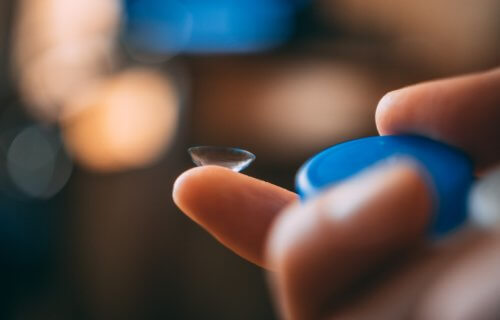
GUILDFORD, United Kingdom — The future appears to be now, at least when it comes to contact lenses. An international team of scientists including researchers from Harvard, George Washington University, and the University of Surrey report the development of a groundbreaking new way to create ultra-thin sensors for smart contact lenses.
This new contact lens sensor system is full of surprising and convenient features. The sensors include a photodetector that receives optical information and a temperature sensor that can identify potential corneal diseases. It even contains a glucose sensor capable of directly monitoring blood sugar in tear fluid.
“Our ultra-thin sensor layer is different from the conventional smart contact lenses — with their rigid or bulk sensors and circuit chips that are sandwiched between two contact lens layers and make contact with tear fluids via microfluidic sensing channels. This new layer could instead be mounted onto a contact lens and maintain direct contact with tears, thanks to its easy assembly, high detection sensitivity, good biocompatibility and mechanical robustness; further, it doesn’t interfere with either blinking or vision,” says first study author Dr. Shiqi Guo, a postdoctoral research fellow at Harvard, in a university release.
“This multifunctional contact lens with field-effect transistors can provide diversified signals from eyes, which could be combined with advanced data analysis algorithms to provide personalized and accurate medical analysis for users,” adds professor Sheng Zhang, a study co-author from Zhejiang University. “This kind of research will also become one of the major research directions at the Ningbo Research Institute.”
Smart contacts could help to fight the pandemic too?
Study authors say they were motivated to engage in this work by the COVID-19 pandemic. While their efforts mainly focused on smart lenses, the sensor they developed can also help complete various medical purposes.
“The COVID-19 pandemic has had an enormous impact on the entire scientific community, with many of us asking how our work could help those suffering from similar future medical emergencies. We are confident that devices that utilize our sensor layer system could be used as a non-invasive way to help monitor and diagnose people’s health. Our results provide not only a unique and simple method for manufacturing advanced smart contact lenses but also novel insight for designing other multifunctional electronics for human-machine interface,” concludes co-author Dr. Yunlong Zhao from the University of Surrey.
The study is published in Matter.
